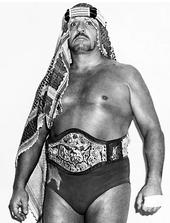Edward Farhat was born to a family of Lebanese immigrants in Michigan. He was a star football player in high school and college for the University of Michigan and served in the army during World War II before he became a foreign heel as "The Sheik of Araby" or later, just "The Sheik." He started out wrestling in the Midwest and later in Texas but his biggest match was one he didn't wrestle in. He was set to face NWA World Heavyweight Champion Lou Thesz in Chicago for his title but Thesz had a reputation for exposing and embarrassing "gimmick" wrestlers so Farhat bailed from the ring and hid under a bus. The publicity from the event helped push the Sheik character to a more prominent level. He went to New York for Vincent J. McMahon where he teamed with Johnny Valentine and Bill Curry in feuds against Mark Lewin and Don Curtis as well as the team of Antonino Rocca and Miguel Pérez in Madison Square Garden. He would return when McMahon formed the World Wide Wrestling Federation to feud with Bruno Sammartino in the WWWF's major markets in the late 1960s.
The Sheik's wrestling was centered around his character of a rich wild man from Syria. He would lock on normally mundane holds and refuse to break them, leading to submission. He used hidden pencils to cut open his opponent's faces. Often, the tactic would backfire and the opponent would get the pencil, leading to the extensive scarring on Farhat's forehead. The other illegal move was his fireball that he threw into his opponents faces and they would sell as if their face was burnt severely. He didn't speak on camera and had two different managers during his career to cut promos on his behalf. His first manager was Abdullah Farouk but when he managed full-time in WWWF, the Jewish Eddy Creatchman became his manager. He kept in character even around his own family, only breaking character around business partners. The character was very easy to go from territory to territory with and Farhat was often brought in as a special attraction for big shows or by NWA promoters who were fighting opposition promotions.
His biggest feud was his seemingly career long feud with Bobo Brazil in the Sheik's main territory, which he would later become the owner of, Detroit. The two feuded over Sheik's version of the United States Championship, frequently selling out the Cobo Arena. This is seen briefly on the "documentary" movie, I Like to Hurt People. The two would take the feud to several markets, most notably Memphis, Tennessee and Los Angeles. His other major opponent in Los Angeles was Fred Blassie. Sheik and Blassie faced off several times, including cage matches in the Grand Olympic Auditorium. He also wrestled regularly in Toronto, where he was undefeated for over 109 matches at the Maple Leaf Gardens. He defeated the likes of Pampero Firpo, Jack Brisco, Dory Funk, Jr., Gene Kiniski, Édouard Carpentier, Ernie Ladd, Jay Strongbow and even André the Giant during his first extensive tour of North America in 1974. Tiger Jeet Singh was the first to defeat him but around that time, business starting going in decline in Toronto because of a few Sheik no-shows and repetitive matches, many of them under ten minutes.
He was brought to Japan by the Japan Pro Wrestling Association to help put over Seiji Sakaguchi after Shohei Baba and Antonio Inoki jumped to start their own promotions. His run was successful but management squandered all the money so when the company went bankrupt, Sheik jumped to Baba's All Japan Pro Wrestling. He jumped a year later to Inoki's New Japan Pro Wrestling but had a falling out and left Japan to work full time in Detroit. He returned in 1977 for All Japan, teaming and feuding with Abdullah the Butcher. His match with Abdullah the Butcher against Dory Funk, Jr. and Terry Funk where Terry fought off Butcher and Sheik with his arm in a sling is credited for turning the foreign Funks into faces in Japan.
After his promotion went bankrupt, he wrestled for various independent promotions throughout the United States and Japan through the 1980s. In 1994, he had a brief run in Extreme Championship Wrestling where he teamed with Pat Tanaka against Kevin Sullivan and Taz. He wrestled his last match in Japan in 1998 at the age of 74. He retired to his own home and was in the process of writing his autobiography when he died on January 18, 2003.
As a promoter, he was somewhat ahead of his time. He had a production truck travel with him to tape the main events in an era when arena shows were almost never taped. He also paid wrestlers while they were out due to injury which didn't come into common practice until recently. When business was bad however, he would get desperate going as far as having his son tell the boys that someone had robbed the ticket office of that nights gate. However, he never groomed a successor so when he stopped drawing crowds, there was no one to fall back on. He was one of wrestling biggest box office attractions and he is seen as a pioneer of "hardcore wrestling" which would become a major part of professional wrestling in the 1990s. He also trained other popular wrestlers from Michigan like his nephew Sabu, Rob Van Dam, Scott Steiner, and Greg "The Hammer" Valentine.
